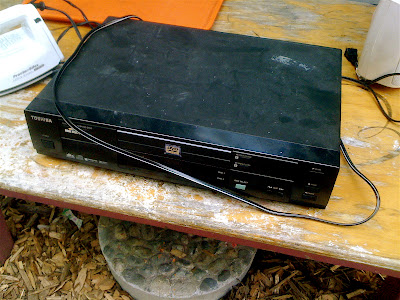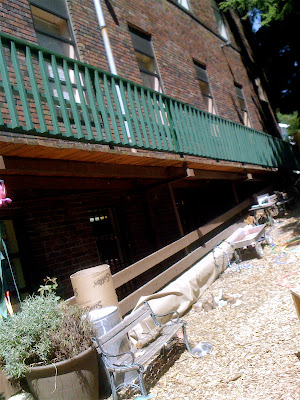Recently, I posted about having received Gever Tulley's book Fifty Dangerous Things (You Should Let Your Children Do) as a gift from Max, and mentioned the plan to spend our summer session giving as many of those things a go as feasible in preschool.
as a gift from Max, and mentioned the plan to spend our summer session giving as many of those things a go as feasible in preschool.
We threw spears, we tried licking 9-volt batteries, we broke glass, set out to master the perfect somersault, hammered nails, threw rocks, and made a bombs in bags. This time we deconstructed appliances.
Personally, I think it's mostly a sad state of affairs that our world is so full of junk appliances that there are always stacks of them around, like a raw material, for children to dismantle. Although, you know, it's also a good thing because as our appliances (e.g., computers, game consoles, etc.) are becoming more complex and hidden inside plastic casings, the gap between the tools our kids can use and what they actually understand is widening. So taking these things apart, I think, is a good way to start to narrow that gap. Because after all, using and understanding tools is one of the most fundamental parts of being human.
We started with 3 likely candidates: an iron . . .
. . . an old radio/cassette player/cd player . . .
. . . and the Toshiba multi-system VHS/DVD player that traveled with my wife and me around the world.
Honestly, I had no high hopes for what we would find inside any of these; mostly circuit boards, I assumed, and no big motors by which to be impressed. Oh, for the days of discarded manual typewriters to disassemble! Now that was a wondrous piece of mechanical engineering. There are so many screws to remove from a single one of those that it once took us a full school year to completely disassemble it. But this is what we had at hand.
We started with a wide variety of screwdrivers of all shapes sizes and lengths, a couple different types of pliers, an adjustable wrench, a pry bar, and wire cutters, all the tools I could imagine us needing.
The iron was easy. Only one screw and it was open. What a simple machine really.
The Toshiba player received the most attention, with lots of tiny Phillips head screws to remove, and wires to cut.
The adults don't always know what everything "does" either, but we try to have speculative discussions with the kids about what the various wires and hinges and levers might do, including drawing connections between what we see on the outside of the machine and what we're seeing on the inside.
What a lot of neat parts it disgorged -- way beyond my expectations.
We maintain a tradition of trying to keep all of the little parts from these machines and naturally there are always many discussions about what we ought to do with them, the idea of building a robot always being among our aspirations. Usually, however, the parts get dumped into our scrap box, which is used for free-form collage projects throughout the school year.
I actually had the highest hopes for the radio. I know there are magnets in the speakers, a system of tiny pulleys that operate the little radio dial, and some interesting mechanics that go with cassette players. Not only that but the screws holding it together were down deep holes that would require some real effort and a long screwdriver, probably one with a magnetized tip, to manage.
The kids worked hard on it, but although it felt like those screws were turning, they wouldn't come out of those deep, narrow holes. I know that our parent-teacher Amanda gave it a good go, then I, assuming the sexist attitude of a man, started wrangling with it, but to no avail. (Note: whenever I act like a sexist, I am always shamed by my arrogance.) We then broke out our pry bars. I took the machine away from the workbench for fear of flying parts. As I did, Amanda warned, "There are a lot screws holding that together. It's going to take a lot of leverage." Our kid-sized 8-inch wrecking bar was inadequate, so I switched to the longest one we keep at the school: 18". I really put my back into it, drawing a small safety goggle be-decked crowd of kids, but other than being able to take a peek at the goodies inside, no luck on getting it fully open.
Okay, it was time for the 1-pound hammer!
Indeed, we were in full-on demolition mode now. What a well-made machine! I suppose I could have really gone to town at this point, sending shards of plastic flying, but thought better of it given that this was, after all, taking place at a preschool, and it was ostensibly, the kid's project, so I turned the hammer over to them and let them take turns doing their best.
We made a little progress, but those insides with all their screws and wires and little bits to explore were still safely encased.
The following day, I gathered some kids around with the challenge: how are we going to get this open? The first idea was to drop rocks on it, so we gathered up the biggest rocks we could find, but they just bounced off. "Maybe if we were higher?" suggested Hattie. So we got the step-ladder and gave it a go.
Okay, so if one rock at a time didn't work, what about two? Three?
We had a core group of about 5 kids working on this project, but Hattie was the leader. She was the one determined to get this radio opened. She suggested that instead of dropping rocks on the radio, maybe we should be dropping the radio. Okay.
We did get the handle off this way, but we felt we were no closer to success. This is when Hattie suggested that the ground was "too soft." We needed to drop the radio on rocks. So it was with this idea that we gathered a pile of rocks, to which several kids added "wood" for good measure. We even arranged a piece of granite counter top so that it "pointed up."
Still no success. That's when Hattie said she felt that we just weren't dropping it from high enough. Maybe if one of the grown-ups, like Teacher Tom, would drop it onto the rocks from the top of the step ladder. Still, nothing dramatic. So, how about if we dropped it from even higher?
We moved out pile of rocks and determined that this would be a job for Teacher Tom. The first drop: nothing. Thomas shouted from the sand pit, "Throw it down next time!" By now all the kids and all the adults were ringed around the target zone at what we figured was a safe distance. Who knew what would happen.
I gave it a forceful throw, missing the rock pile, which in my defense was only about a foot in diameter. The kids converged on the radio as it lay on the ground, Hattie in the lead, sticking her fingers in to see if she could get it apart. As I picked up the radio, declaring, "This time I'll hit the rocks," the whole thing fell apart. Success!
This photo is a recreation because I wasn't able to get it out of Hattie's hands for some time.
Next week we'll finish removing all those screws, playing with the magnets and investigating the little pulleys.



























9 comments:
We are always begging for old appliances or, failing donations, buying whatever Goodwill has for $1. We deconstruct them at a long workbench outside that a former class shortened, sanded, painted, and crowbarred the old warped top off of. A friend attached a new top (although interested kids got to watch.) When screwdrivers fail, we also resort to leverage, but I'm always amazed at how long the kids will keep trying screwdrivers. I must admit that after a day's failure, I have tried to loosen the screws for them. (Why should they have all the fun?) Then the parts are saved for collage work AND sent to the outdoor clay table for adding to clay sculptures.
This is very inspiring, and I think a great use of these throw away appliances that clutter our world. I think it's because of disposable appliances that our children are experiencing that disconnect between how things work, and to some extent loosing the impetus to ask why.
I really want a copy of that book now, it's right up my alley!
Old telephones with real bells inside are my personal favorites. I found my box of old ones today in the bottom back of the pre k closet! My faithful and trusty assistant asked me why? (again) Why do you have so many telephones? I have to remind her often that being a bag lady is a good thing. She has threatened to turn me in to that TV show called Hoarders. Currently, I am all out of odl tape players, but I do have an old VCR player and... a microwave!
Some of those old appliances can definitely be used for art or even recycling. It's a sad state when we hear that they're thrown in the trash for kids to play with. What a waste!
When I was a kid my Dad would alternate taking my sister and I to work with him, and one day he asked me if I would like to dismantle some computers and salvage some parts. Heck yes! I distinctly remember pulling out hard drives, saving light bulbs and transistors because I thought they looked cool, and getting all kinds of little cuts on my hands, but I learned a lot about the inside of a computer, and built a lot of confidence in my ability to work with my hands. Taking things apart is a great way to learn how to put them back together again!
Another example of children using authentic real life tools. I just love that!
Donna & Sherry posted about tinkering with appliances a little while ago. http://www.playbasedlearning.com.au/2011/03/the-tinkering-table/
I'll be posting something soon about real tools so keep a look out.
I stumbled upon this blog yesterday and was so inspired I went home and told my family all about it. Everyone was so excited we decided to deconstruct an old printer. My kids 4 years and 18 months as well as my husband had a blast. I'll never throw another old piece of equipment away again. By the way old printers are awesome - 3 motors, gears, belts, and multiple curcuit boards.
Thanks for this post. It Very nice article. It was a very good article. I like it. Thanks for sharing knowledge. Ask you to share good article again.
We love tinkering at our Kindergarten and we went on to making framed pictures from assorted items from the tinkered appliances. They looked great and the children were very inventive describing them as robots and aliens. Great way to reuse and recycle.
Post a Comment